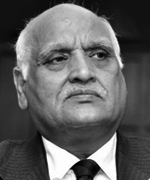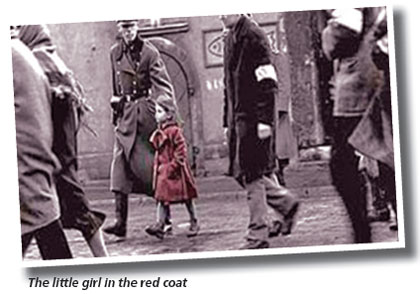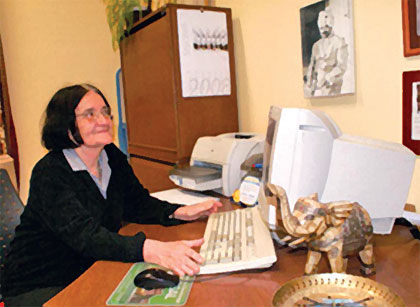How the ‘Good Maharaja’ sheltered 2,000 Polish children orphaned by the Nazis
 Maj. Gen. Raj Mehta (retd)
Maj. Gen. Raj Mehta (retd)
It was the summer of 2002. A Brigadier level staff officer in the Military Operations, Director, Army HQ, I was informed after a briefing to the Army Chief that I would accompany him to Israel on an official visit a few days later and coordinate the visit with my Israeli counterparts.
The visit had specific military content but the evenings had cultural content, one keenly-anticipated being a visit to the Yad Veshem Holocaust Museum, Jerusalem. That two hour visit impacted our delegation deeply, from reception by a lady guide dressed in all black to her exacting description of the visit’s purpose and the protocol for going through the largely black-and-white displays and exhibits related to the five million Jewish victims of the Holocaust…We saw a hill of just spectacles of victims…another of teeth with gold fillings…an immensely saddening hill of dolls, some broken, some blood stained… and so much more.
What hit us with an Armageddon of emotions and grief after we entered a huge, dark cavern was suddenly coming face-to-face with a larger than life black-and-white portrait of a little coat wearing angelic Jewish girl with the world’s most cherubic, innocent, infectious smile. She was clutching her pretty doll by its arms. There was a stark candle lighting up the little girl’s beatific face. Looking around the cavern slowly, we realised that the candle flame was replicated in millions of convex glass pieces embedded into the cavern walls and ceiling…five million glass pieces. In the background, a haunting Jewish lament played…an ode to devastating loss of three generations of Jews. A stark line under the girl’s portrait informed viewers that, shortly after the picture was taken, the girl was exterminated in Auschwitz…Birkenau…Treblinka Death Camp…I cannot recall which. What mattered was the proud, delicate-yet-strong sensitive face of our guide. There was nothing she said; her silence said it all. We had entered the souls of the victims and were deeply moved to silence.
An Indian Connection
India, like Israel, is an ancient country with huge inherent strength, tolerance and secular ideals in its DNA with the motto of Atithi Devo Bhava (The Guest is God) and Vasudhaiva Kutumbakam (The world is one family). It has been through serial genocides, the most devastating being the Partition Holocaust of 1947 and yet, like Israel, has come out resilient and persevering. What is more important is that in India, the core DNA of treating the world as a family; treating guests like God are still cherished ideals.
One sterling example of such peerless DNA was Maharaja ‘Jam Sahib’ Capt (later Hony Lt Gen) Digvijaysinhji Ranjitsinhji Jadeja of Jamnagar (Nawanagar), Gujarat. Around 1200 orphaned Polish children for whom he was ‘Bapu’ (Father) during the Great War years of 1942-1947 never forgot “the good King” who created Little Poland for them in his Kingdom in Gujarat; facilitated similar such habitats for other Polish children/parents in neighbouring Maharashtra – because he had the power and position to do so; and the humanism.
This story is about this unusual King whom his mischievous Polish children affectionately nicknamed “Big Jam” who visited them with toffees and money in his pockets. However, before revealing his story, let’s examine why in retrospect, the survivors among those he benefited and their ancient country of Poland salute the good King; their Bapu–as an Indian Schindler.
The Indian Schindler
In real life, German businessman and Nazi sympathiser Oskar Schindler was, to start with, a vain and greedy German businessman; a suave man-about-town with many Nazi connections which he exploited for financial gain. He became an unlikely humanitarian when face-to-face with an incident of horrendous Nazi barbarism. It drove him to provide some Jews refuge under false pretexts–in a conquered Poland where Hitler’s orders were to eliminate Jews of all genres.

(later Honorary Lt Gen)
Digvijaysinhji Ranjitsinhji
Jadeja of Jamnagar
(Nawanagar)
Post his conversion to humanism, he saved over 1100 Jews from certain extermination in the gas chambers of Auschwitz/ Birkinau/ Treblinka. His remarkable turnaround was captured in Schindler’s List, an epic 1993 American historical film directed by Steven Spielberg, a Jew. It stars award-winning Liam Neeson as Schindler and Ben Kingsley as Schindler’s Jewish accountant. Listed among the greatest films ever made for its “tone, acting, atmosphere and Spielberg’s direction”, the film won seven Academy Awards; was nominated for more and is 8th on the list of the 100 best American films ever made.
The opening scene in this primarily black-and-white Holocaust film features a scene in Technicolor in which a Jewish family is shown observing Shabbat rituals with ceremonial candles being lit. The colour then fades out, giving way to a grey world in which smoke and flames symbolize Jewish bodies being burnt at the Death Chambers. Only at the end when Shabbat is observed again do the images of lighted candles regain their warmth. For Spielberg, they represented “just a glint of colour; a glimmer of hope.” The two scenes bracket the Nazi era, marking its ghastly beginning and end.
The Little Girl in The Red Coat
A scene which becomes the film’s turning point depicts Schindler seeing a three year old Polish girl in a red coat during the liquidation of the Kraków Ghetto in Poland. Later, Schindler sees her exhumed dead body, recognizable only by the red coat she is still wearing.  That is the point when his deeply interred humanism manifests. He no longer sees “the ash and soot of burning corpses piling up on his car as an annoyance.” Instead, the red coated little girl symbolises “innocence, hope; the blood of Jews sacrificed in the Holocaust.”
That is the point when his deeply interred humanism manifests. He no longer sees “the ash and soot of burning corpses piling up on his car as an annoyance.” Instead, the red coated little girl symbolises “innocence, hope; the blood of Jews sacrificed in the Holocaust.”
Readers are left free to extrapolate between the Jerusalem Holocaust cavern depictions; the film Schindler’s List; the turn-around in it hinged on Schindler seeing the innocent little girl dead. Is there a connection between the films turn-around point and the Holocaust Museum depiction?
What is more important is that, when the western world savagely forsook the orphaned children, an Indian Schindler of amazing pedigree and compassion reached out, becoming Bapu for them without any preconditions.
Why the Jewish Exodus?
Poland (Flat land) is an ancient Central Europe country with Warsaw as its capital and major cities like Kraków, Łódź, Poznań and Gdańsk. It is noteworthy that all German death camps to exterminate Jews in World War II were located in Poland. The country is sandwiched between Germany in the West and Russia in the East. Mainly Catholic, it had a large Jewish population.
Post its prosperous and culturally dominant status for centuries, it began getting divided in the 18th century but regained its sovereignty after the 1918 Versailles Treaty; a situation that was historically anathema to both Germany and Russia. In September 1939, World War II began with the invasion of Poland by Germany, followed by the Soviets also invading Poland in accordance with the Molotov–Ribbentrop Pact. They divided Poland between them.
Approximately six million Polish citizens, including three million Polish Jews, perished during the war. The Holocaust in Poland was marked by the construction of death camps by Nazi Germany, German use of gas vans, and mass shootings by German troops and extermination camps, which played a central role in the extermination both of Polish Jews and of Jews transported to their deaths from Western and Southern Europe. The Soviet NKVD (interior ministry) also exterminated thousands of Poles, relocating 1.7 million Poles in labour camps in Siberia with only views of pine and frozen steppe. “The Soviets deported the Polish people and Western historians deported the event from history” writes historian Anuradha Bhattacharjee.
There was however a later thaw in Soviet outlook when Germany invaded USSR in June 1941 under Operation Barberossa. This is when the USSR announced a general amnesty leading to the release of Polish exiles from labour camps with the aim of forming a Polish Army Corps to fight the Germans. Thus began a great exodus—from the cold parts of the Soviet Union to warmer southern regions of Central and South Asia.

The King Gets Involved
As the horrors of the Holocaust and WW II unfolded in Europe, Gen Władysław Sikorski–the first Prime Minister of the Polish Goverment-in-Exile and C-in-C Polish armed forces–requested British Prime Minister Winston Churchill to protect the starving young children who were the ‘treasure of Poland’. India, then a British colony, was suggested as one possible destination. The British were diffident due to political, financial and diplomatic reasons, though obliged by treaty along with France to protect Poland. This is where the Jam Sahib who, as a Maharaja, had considerable autonomy resolutely stepped in.
The erudite, charming and wise 46 year old, Malvern College, UK educated ex-British-Indian Army officer had interacted with his father’s friend and neighbour in Geneva, the Polish diplomat and pianist Ignacy Paderewski as a child and developed an abiding interest in the people and culture of this great nation. He felt he must do all he could to “save the children; make them healthy so that they could…cope with the tasks awaiting them in a liberated Poland.”
Commissioned into the British-Indian Army in 1919, he was attached to 125th Napier’s Rifles (now 5 Raj Rif), had operational service in Egypt and Waziristan and had retired as a Captain in 1931; attaining an Honorary Lt Gen’s rank in later life for outstanding public service. Charmed by his earnestness and humanism, the British made a virtue out of necessity and gave him the go-ahead.
 It helped that he was President of the Chamber of Princes and was serving in the Imperial War Cabinet and the National Defence Council along with the Pacific War Council and therefore had both credibility and connections. Jam Sahib knew the officials of the Polish Government-in-exile that operated from London and coordinated the children’s movement to India with savoir faire.
It helped that he was President of the Chamber of Princes and was serving in the Imperial War Cabinet and the National Defence Council along with the Pacific War Council and therefore had both credibility and connections. Jam Sahib knew the officials of the Polish Government-in-exile that operated from London and coordinated the children’s movement to India with savoir faire.
The Maharaja donated liberally besides raising a huge sum of Rs 6,00,000 between 1942 and 1945 from Princely colleagues, especially the Maharajas of Kohlapur, Baroda and Patiala, Tata’s and private donations to build the refugee camps. These came up not just in his seashore Balachadi Estate in Nawanagar (Jamnagar) where he housed 1200 Polish orphans (entirely funded by him) but also in Valivade suburb of Kohlapur; in Bandra, Bombay; Chela and Panchgani in the Western Ghats. Eventually around 15,000 Polish citizens were housed.
The Jamnagar Camp
The first batch of severely malnourished and exhausted orphans had a surprise welcome, when they arrived in Nawanagar from the Maharaja himself. “Don’t consider yourselves orphans. You are now Nawanagaris and I am Bapu, the father of all Nawanagaris, including yourselves,” he said.
The site of the specially constructed facility at Balachadi Estate for Polish Children was the Maharaja’s well-spread-out seaside summer resort on the outskirts of Jamnagar city which now houses Gujarat’s only Sainik School. Village Balachadi (lofty) takes its name after some rocky bluffs which dominate the Gulf of Kutch. It is famous for its profusion of commercially marketed Aloe Vera and its extended semi-circular fish-trapping rocky enclosures where the receding tides leave stranded large fish like sawfish, dugongs and sharks behind. Pearl oysters are also found in the coral reefs around Balachadi.
Balachadi Camp had more than 60 buildings, including a chapel, laundry rooms, a stage to hold Polish and Indian cultural programmes; a community centre to hold Saturday evening dances for growing adults and well kept sports grounds.
Jam Sahib not just welcomed the refugees, but had schools, medical facilities and opportunities for rest and recuperation at Balachadi. He ensured that education was imparted in Polish by Polish teachers apart from arranging theology priests to follow the religious mores of the refugees. Between 1942 and 1947, these children lived under his protection, maintained by his purse.

Tomek Gutowski (right) is the son of Roman Gutowski (centre) who came to Balachadi in 1942 when his father was forced to join the Polish Army in the Soviet Union
Survivors recall ‘Little Poland’
Poland is today a flourishing, prosperous democracy with an excellent educational and health system. Survivors who grew up in the Little Poland camps in India visit every now and then and recall a joyous childhood spent in India during the war years. Roman Gutowski, 83, a retired Polish civil engineer, pulls back the grey bus curtains on one of the windows and peers out toward approaching Jamnagar. He recalls that lists were drawn up of teachers, clergymen, the intelligentsia and army officers for public execution; more than two million Jews died in concentration camps. Gutowski’s father was forced to soldier for the Soviet Union;

It was here that seven-year-old Roman Gutowski first saw an elephant; where Wieslaw Stypula, 15, held up a cornet; where 10-year-old Josephine Salva learnt to sing in Gujarati; where Zbigniew Bartosz, aged 8, learnt how to be popular. “The Maharaja visited our camp with his pockets full of toffees, which I was entrusted to distribute…. I have never had so many friends,” recalls Bartosz, now 74.
Survivors remember meeting Jam Saheb’s children. Says Hershad Kumari, the Jam Saheb’s eldest daughter: “We would meet them when we went to spend our summers in Balachadi from Jamnagar and on special occasions, they were invited to the palace and could use the squash courts and swimming pool. They were in bad shape due to malnutrition, disease, the arduous travel, but they slowly recovered full health at Balachadi.”
At Balachadi and Valivade Camps, there were tuck shops, proper schools, a kindergarten, an auditorium, wooden barracks with running water, and medical care. These facilities gave the children a sense of home and psychological stability.
When he was six years old, survivor Feliks Scazighino recalls that his family was deported. “I remember our life in Siberia, all our illnesses and deprivations and hunger. When we got out of Russia we looked like skeletons. We all had to be deloused, our hair had to be shaved off, and our clothes burned.” 88 year old Karolina Rybka who now lives in British Columbia recalls: “Nobody else wanted us,”. Not the Americas, well off European nations; no one… India did.
 Karolina Rybka
Karolina Rybka
A heart touching recall is that of the daughter of Josephine Salva. Jo was one of the children of the first batch who came to Balachadi from the Soviet Union. Dressed in a white peasant blouse and skirt with a black scarf tied in a knot around her head, her lips moved all evening, singing that one song to no one in particular. Jai Jai Maharaja… is how it went. Jo sang it on special occasions when the Jam Saheb was visiting. The lines she was singing were in Gujarati. “It’s the song mom never stopped singing at home.” One week after her visit, Jo died. There are similar nostalgic recalls from Valivade refugee camp.
Honours and Awards
In 2016, 50 years after Jam Saheb’s death, Poland’s Parliament unanimously adopted a special resolution honouring him for his aid to the Polish refugee children he sheltered. A jointly produced, well-received 2017 Indo-Polish documentary film is ‘Little Poland in India’ whose executive producer/ co-director is India-based Bene Merito award winning film maker Anu Radha. She succinctly covers the collaborative efforts of Jam Sahib with support of the Polish consulate in Bombay: Consul Eugeniusz Banasinski and his wife Kira to rehabilitate Polish refugees. Today, six private schools in the Polish capital city, Warsaw, are named in honour of the Maharaja with much school classroom graffiti depicting classical Indian themes.

The Maharaja was posthumously awarded the President’s medal, Poland’s highest honour. In history-bedecked Warsaw, one can visit the Square of the ‘Good Maharaja’. In 1987, a group of survivors collected enough money to build the great humanist a commemorative plaque at Sainik School Balachadi.
In conclusion, when India reached out to help, it wasn’t the best of times. India was fighting for Independence, wasn’t rich and had complex problems. Yet, it did reach out in line with its ancient DNA. By planting the Polish flag in all refugee camps, India had said all that needed saying–without saying it. It is time we gird our lions and make a memorable historical film on him better than Spielberg made on Schindler and on Gandhi. About time someone made The Good Maharaja.

